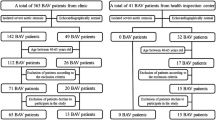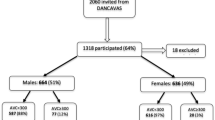Abstract
Predictors of aortic dilatation are not well described in patients with bicuspid aortic valves (BAV). This study sought to examine the relationship between proximal aortic dilatation and matrix metalloproteinase-9 (MMP-9) and alpha 1-antitrypsin (α1AT) levels in patients with BAV. All patients underwent echocardiography using a standard protocol, and aortic measurements were taken in end-diastole. We studied 82 patients with BAV and categorized them into two groups according to aortic dimensions corrected for body surface area and age. The plasma level of α1AT was routinely determined using a BN ProSpec analyzer (Siemens Healthcare Diagnostics, Marburg, Germany), and that of MMP-9 were determined by ELISA (RayBiotech Inc. Norcross, GA, USA). Statistical analysis was performed using the Statistical Package for Social Sciences (SPSS; SPSS Inc., Chicago, IL, USA) software for Windows version 12. This study included patients with BAV with no or mild valvular impairment. There were no significant differences between groups in terms of gender, body surface area, associated hypertension, diabetes mellitus, hyperlipidemia, or smoking. The mean ascending aortic diameter was 4.38 ± 0.5 mm in group 1 and 3.34 ± 0.35 mm in group 2 (p < 0.001). Plasma concentration of α1AT in patients with ascending aortic dilatation was significantly lower than that in the non-dilated group (1.32 ± 0.27 and 1.49 ± 0.25 g/l, respectively; p = 0.005). However, no significant difference was found in the MMP-9 level between the two groups (336.49 ± 233.11 and 336.39 ± 268.072 pg/ml, respectively; p = 0.96). We observed a significantly negative correlation between ascending aortic diameter and α1AT level (r = −0.300, p = 0.006) and a positive correlation between ascending aortic diameter and age (r = 0.413, p < 0.001). No significant correlation was found between plasma MMP-9 concentration and ascending aortic diameter (r = −0.008, p = 0.94). A multiple linear regression analysis was performed, including age, α1AT level, MMP-9 level, and left ventricular diastolic diameter. In this analysis, α1AT level and age were the independent predictors of aortic dilatation (p = 0.03 and p = 0.02, respectively).



Similar content being viewed by others
References
Guntheroth WG (2008) A critical review of the American College of Cardiology/American Heart Association practice guidelines on bicuspid aortic valve with dilated ascending aorta. Am J Cardiol 102:107–110
Tutar E, Ekici F, Atalay S, Nacar N (2005) The prevalence of bicuspid aortic valve in newborns by echocardiographic screening. Am Heart J 150:513–515
Lindsay J Jr (1988) Coarctation of the aorta, bicuspid aortic valve and abnormal ascending aortic wall. Am J Cardiol 61:182–184
Braverman AC (1996) Bicuspid aortic valve and associated aortic wall abnormalities. Curr Opin Cardiol 11:501–503
Ferencik M, Pape LA (2003) Changes in size of ascending aorta and aortic valve function with time in patients with congenitally bicuspid aortic valves. Am J Cardiol 92:43–46
Roberts WC (1970) The congenitally bicuspid aortic valve. A study of 85 autopsy cases. Am J Cardiol 26:72–83
de Sa M, Moshkovitz Y, Butany J, David TE (1999) Histologic abnormalities of the ascending aorta and pulmonary trunk in patients with bicuspid aortic valve disease: clinical relevance to the Ross procedure. J Thorac Cardiovasc Surg 118:588–594
Parai JL, Masters RG, Walley VM, Stinson WA, Veinot JP (1999) Aortic medial changes associated with bicuspid aortic valve: myth or reality? Can J Cardiol 15:1233–1238
Nistri S, Sorbo MD, Basso C, Thiene G (2002) Bicuspid aortic valve: abnormal aortic elastic properties. J Heart Valve Dis 11:369–373
Niwa K, Perloff JK, Bhuta SM, Laks H, Drinkwater DC, Child JS, Miner PD (2001) Structural abnormalities of great arterial walls in congenital heart disease: light and electron microscopic analyses. Circulation 103:393–400
Busuttil RW, Rinderbriecht H, Flesher A, Carmack C (1982) Elastase activity: the role of elastase in aortic aneurysm formation. J Surg Res 32:214–217
Crystal RG (1990) Alpha 1-antitrypsin deficiency, emphysema, and liver disease. Genetic basis and strategies for therapy. J Clin Invest 85:1343–1352
Lomas DA, Parfrey H (2004) Alpha 1-antitrypsin deficiency. 4: molecular pathophysiology. Thorax 59:529–535
Visse R, Nagase H (2003) Matrix metalloproteinases and tissue inhibitors of metalloproteinases: structure, function, and biochemistry. Circ Res 92:827–839
Cohen JR, Mandell C, Chang JB, Wise L (1988) Elastin metabolism of the infrarenal aorta. J Vasc Surg 7:210–214
Cohen JR, Sarfati I, Ratner L, Tilson D (1990) Alpha 1-antitrypsin phenotypes in patients with abdominal aortic aneurysms. J Surg Res 49:319–321
Vega de Céniga M, Esteban M, Quintana JM, Barba A, Estallo L, de la Fuente N, Viviens B, Martin-Ventura JL (2009) Search for serum biomarkers associated with abdominal aortic aneurysm growth—a pilot study. Eur J Vasc Endovasc Surg 37:297–299
Lesauskaite V, Tanganelli P, Sassi C, Neri E, Diciolla F, Ivanoviene L, Epistolato MC, Lalinga AV, Alessandrini C, Spina D (2001) Smooth muscle cells of the media in the dilatative pathology of ascending thoracic aorta: morphology, immunoreactivity for osteopontin, matrix metalloproteinases, and their inhibitors. Hum Pathol 32:1003–1011
McMillan WD, Tamarina NA, Cipollone M, Johnson DA, Parker MA, Pearce WH (1997) Size matters: the relationship between MMP-9 expression and aortic diameter. Circulation 96:2228–2232
Golledge J, Tsao PS, Dalman RL, Norman PE (2008) Circulating markers of abdominal aortic aneurysm presence and progression. Circulation 118:2382–2392
Roman MJ, Devereux RB, Kramer-Fox R, O’Loughlin J (1989) Two-dimensional echocardiographic aortic root dimensions in normal children and adults. Am J Cardiol 64:507–512
Lang RM, Bierig M, Devereux RB, Flachskampf FA, Foster E, Pellikka PA, Picard MH, Roman MJ, Seward J, Shanewise JS, Solomon SD, Spencer KT, Sutton MS, Stewart WJ (2005) Chamber Quantification Writing Group; American Society of Echocardiography’s Guidelines and Standards Committee; European Association of Echocardiography. Recommendations for chamber quantification: a report from the American Society of Echocardiography’s Guidelines and Standards Committee and the Chamber Quantification Writing Group, developed in conjunction with the European Association of Echocardiography, a branch of the European Society of Cardiology. J Am Soc Echocardiogr 18:1440–1463
Zoghbi WA, Enriquez-Sarano M, Foster E, Grayburn PA, Kraft CD, Levine RA, Nihoyannopoulos P, Otto CM, Quinones MA, Rakowski H, Stewart WJ, Waggoner A, Weissman NJ (2003) American Society of Echocardiography. Recommendations for evaluation of the severity of native valvular regurgitation with two-dimensional and Doppler echocardiography. J Am Soc Echocardiogr 16:777–802
Aboulhosn J, Child JS (2006) Left ventricular outflow obstruction: subaortic stenosis, bicuspid aortic valve, supravalvar aortic stenosis, and coarctation of the aorta. Circulation 114:2412–2422
Elzouki AN, Eriksson S (1994) Abdominal aortic aneurysms and alpha 1-antitrypsin deficiency. J Intern Med 236:587–591
St Jean P, Hart B, Webster M, Steed D, Adamson J, Powell J, Ferrell R (1996) Alpha-1-antitrypsin deficiency in aneurysmal disease. Hum Hered 46:92–97
Elzouki AN, Rydén Ahlgren A, Länne T, Sonesson B, Eriksson S (1999) Is there a relationship between abdominal aortic aneurysms and alpha 1-antitrypsin deficiency (PiZ)? Eur J Vasc Endovasc Surg 17:149–154
Parks WC (2002) A confederacy of proteinases. J Clin Invest 110:613–614
Naito Y, Tsujino T, Lee-Kawabata M, Matsumoto M, Ezumi A, Nakao S, Goda A, Ohyanagi M, Masuyama T (2009) Matrix metalloproteinase-1 and -2 levels are differently regulated in acute exacerbation of heart failure in patients with and without left ventricular systolic dysfunction. Heart Vessels 24:181–186
Longo GM, Xiong W, Greiner TC, Zhao Y, Fiotti N, Baxter BT (2002) Matrix metalloproteinases 2 and 9 work in concert to produce aortic aneurysms. J Clin Invest 110:625–632
McMillan WD, Pearce WH (1999) Increased plasma levels of metalloproteinase-9 are associated with abdominal aortic aneurysms. J Vasc Surg 29:122–127
Koullias GJ, Korkolis DP, Ravichandran P, Psyrri A, Hatzaras I, Elefteriades JA (2004) Tissue microarray detection of matrix metalloproteinases, in diseased tricuspid and bicuspid aortic valves with or without pathology of the ascending aorta. Eur J Cardiothorac Surg 26:1098–1103
Boyum J, Fellinger EK, Schmoker JD, Trombley L, McPartland K, Ittleman FP, Howard AB (2004) Matrix metalloproteinase activity in thoracic aortic aneurysms associated with bicuspid and tricuspid aortic valves. J Thorac Cardiovasc Surg 127:686–691
Tzemos N, Therrien J, Yip J, Thanassoulis G, Tremblay S, Jamorski MT, Webb GD, Siu SC (2008) Outcomes in adults with bicuspid aortic valves. JAMA 300:1317–1325
LeMaire SA, Wang X, Wilks JA, Carter SA, Wen S, Won T, Leonardelli D, Anand G, Conklin LD, Wang XL, Thompson RW, Coselli JS (2005) Matrix metalloproteinases in ascending aortic aneurysms: bicuspid versus trileaflet aortic valves. J Surg Res 123:40–48
Fedak PW, de Sa MP, Verma S, Nili N, Kazemian P, Butany J, Strauss BH, Weisel RD, David TE (2003) Vascular matrix remodeling in patients with bicuspid aortic valve malformations: implications for aortic dilatation. J Thorac Cardiovasc Surg 126:797–806
Kitzman DW, Scholz DG, Hagen PT, Ilstrup DM, Edwards WD (1988) Age-related changes in normal human hearts during the first 10 decades of life. Part II (Maturity): a quantitative anatomic study of 765 specimens from subjects 20 to 99 years old. Mayo Clin Proc 63:137–146
Cecconi M, Manfrin M, Moraca A, Zanoli R, Colonna PL, Bettuzzi MG, Moretti S, Gabrielli D, Perna GP (2005) Aortic dimensions in patients with bicuspid aortic valve without significant valve dysfunction. Am J Cardiol 95:292–294
Nistri S, Grande-Allen J, Noale M, Basso C, Siviero P, Maggi S, Crepaldi G, Thiene G (2008) Aortic elasticity and size in bicuspid aortic valve syndrome. Eur Heart J 29:472–479
Beroukhim RS, Kruzick TL, Taylor AL, Gao D, Yetman AT (2006) Progression of aortic dilatation in children with a functionally normal bicuspid aortic valve. Am J Cardiol 98:828–830
Braverman AC, Güven H, Beardslee MA, Makan M, Kates AM, Moon MR (2005) The bicuspid aortic valve. Curr Probl Cardiol 30:470–522
Schaefer BM, Lewin MB, Stout KK, Byers PH, Otto CM (2007) Usefulness of bicuspid aortic valve phenotype to predict elastic properties of the ascending aorta. Am J Cardiol 99:686–690
Triantafyllidi H, Rizos I, Rallidis L, Tsikrikas S, Triantafyllis A, Ikonomidis I, Panou F, Rigopoulos A, Kremastinos DT (2010) Aortic distensibility associates with increased ascending thoracic aorta diameter and left ventricular diastolic dysfunction in patients with coronary artery ectasia. Heart Vessels 25:187–194
Schaefer BM, Lewin MB, Stout KK, Gill E, Prueitt A, Byers PH, Otto CM (2008) The bicuspid aortic valve: an integrated phenotypic classification of leaflet morphology and aortic root shape. Heart 94:1634–1638
Author information
Authors and Affiliations
Corresponding author
Rights and permissions
About this article
Cite this article
Kilickesmez, K.O., Abaci, O., Kocas, C. et al. Dilatation of the ascending aorta and serum alpha 1-antitrypsin level in patients with bicuspid aortic valve. Heart Vessels 27, 391–397 (2012). https://doi.org/10.1007/s00380-011-0161-1
Received:
Accepted:
Published:
Issue Date:
DOI: https://doi.org/10.1007/s00380-011-0161-1




